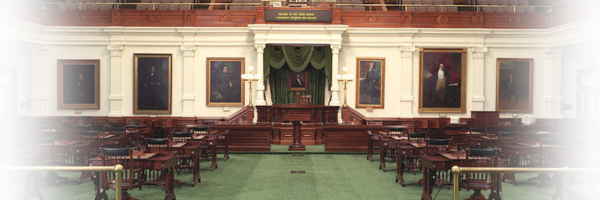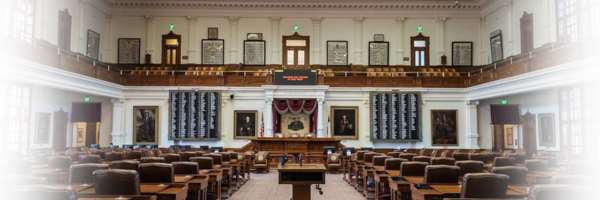Estimated Time to Read: 6 minutes
Quick-Jump
The Structure
The Texas Legislature is bicameral or comprised of two separate legislative bodies. The Texas Senate is known as the ‘upper chamber’ while the Texas House of Representatives is known as the ‘lower chamber’.
Texas Senate

Total Membership: 31 State Senators
Leadership: Presided over by the Lieutenant Governor who is elected among voters statewide
District Type: Single-Member District
Elected Term: 4-years
Texas House of Representatives

Total Membership: 150 State Representatives
Leadership: Presided over by the Speaker of the House who is elected by House membership
District Type: Single-Member District
Elected Term: 2-years
The Legislative Session
The responsibilities of elected lawmakers in the Texas Legislature consist of consideration of proposed constitutional amendments can
Regular Session

Frequency: Every odd-numbered year
Length: 140 days
Topics Considered: State Budget for the next biennium and any other issue
Special Session

Frequency: Upon proclamation of the Governor
Length: Up to 30 days
Topics Considered: Issues designated by the Governor
The Legislative Process
The legislative process is largely one guided by parliamentary norms, with each legislative chamber following its own adopted rules as a guide. The process is designed to be limiting, ensuring the bulk of proposed legislation needs consensus and is the result of compromise. Different types of legislation could be proposed including House and Senate Resolutions, House and Senate Bills, House and Senate Joint Resolutions, and House and Senate Concurrent Resolutions. Most types of legislation follow the process as featured below.
Proposed constitutional amendments that will eventually find themselves being considered by Texas voters take the form of House or Senate Joint Resolutions while being considered by the legislature and follow a slightly different path in that once adopted by each legislative chamber, instead of being directed to the Governor for consideration it instead gets filed with the Texas Secretary of State to eventually be put on the ballot.
Process for House Bills
Process for Senate Bills
Introduction of Legislation
Generally speaking, lawmakers can introduce legislation anytime between the pre-filing period (which begins the first Monday after the general election preceding the next legislative session) and 60 days into the legislative session. Though legislation may be introduced beyond that period, it requires a vote of the overall legislative body.
Once introduced, it is subjected to a ‘first reading’ in front of the legislative chamber it was introduced and referred to a legislative committee.
Committee Action
The chairman of a committee can determine whether or not to allow the proposed legislation a public hearing and consideration by the committee. In a committee hearing, the legislation could be subjected to amendment or substitution before being voted out.
If proposed legislation is voted favorably out of a legislative committee it is then sent to the appropriate calendar committee whereby it is then scheduled for consideration by the overall legislative body.
For a comprehensive list of standing legislative committees go here.
Floor Action
Once proposed legislation is scheduled for overall floor consideration it is introduced for ‘second reading’ and subjected to debate and amendment before being voted on. If successful it passes to ‘third reading’ whereby it is again subjected to debate and amendment, albeit the threshold for successful amendment is higher.
Once proposed legislation passes a ‘third reading’ it is sent to the opposite legislative chamber to follow generally the same process.
If the proposed legislation is altered in any way while being considered by the opposite legislative chamber before being passed, the originating chamber determines whether to adopt the proposed legislation with those amendments, thereby sending it to the Governor, or to appoint a conference committee to reconcile the differences. If a conference committee is appointed, they then produce a conference committee report with reconciled differences that each legislative chamber chooses to adopt. If successful, that newly adopted report is sent to the Governor.
Governor Action
Once proposed legislation makes its way to the Governor’s desk, the Governor can then choose whether to sign the proposed legislation into law, not sign it for a period thereby making it law, or veto the legislation.
The legislature can override a Governor’s veto by a vote of two-thirds from each legislative chamber.
The Legislative Timeline

Pre-Session
The Legislative Budget Board solicits ‘Legislative Appropriation Requests’ or LARs from all state agencies/organizations in the Summer preceding the legislative session. These LARs are used to guide the development of the draft General Appropriations Act or proposed state budget for lawmakers to consider for the next biennium. For more on the State Budget process go here.
Lawmakers can pre-file legislation ahead of the regular legislative session starting on the first Monday after the general election.
First 60 Days
The first 60 days of the legislative session are generally uneventful concerning action on proposed legislation. Lawmakers are precluded from considering legislation not deemed an emergency before the bill filing deadline. Most of the time is instead dedicated to swearing in lawmakers, assigning lawmakers to committees, receiving updates from the Governor via the State of the State Address, and the judiciary via the State of the Judiciary Address, as well as the adoption of congratulatory and memorial resolutions.
Most committees do not start meeting until after this period except maybe a few for organizational purposes or the House Appropriations and Senate Finance Committees to solicit answers on budget items.
Second 60 Days
Once beyond the bill filing deadline, proposed legislation begins moving through the legislative process. Priority legislation of the Governor, Lieutenant Governor, and Speaker of the House have historically been the proposed legislation that moves quickest.
The General Appropriations Act, or proposed state budget for the next biennium has also historically been considered during this time by each legislative chamber. It almost certainly gets amended in each legislative chamber and is subjected to a conference committee.
Final 20 Days
This period is generally subject to several self-imposed deadlines as the legislative session winds down. Many of these deadlines preclude the consideration of specific types of legislation and many pieces of proposed legislation end up never being considered at all.
The conference committee report for the General Appropriations Act is normally considered in this period as well. Once passed it goes to the State Comptroller for certification before heading to the Governor.
For more on key legislative dates and deadlines go here.
Post-Session
Beyond the legislative session, the Governor has a small amount of time to finalize his decisions on proposed legislation that made it through the entirety of the legislative process. Legislation that passed with a specific vote threshold and had a specified effective date goes into effect. Most legislation goes into effect 91 days beyond the legislative session.
In a period well beyond the regular legislative session, leadership in each legislative chamber issues what are known as ‘Interim Charges’ directing committees to study specific issues ahead of the next legislative session. The results of those studies are compiled into ‘Interim Reports’ detailing the committee’s findings and recommendations ahead of the next legislative session.
For more resources go here.
Texas Policy Research relies on the support of generous donors across Texas. If you found this information helpful, please consider supporting our efforts! Thank you!



